Chrysotile asbestos veins in serpentinized komatiite (Upper Komatiitic Unit, Kidd-Munro Assemblage, Neoarchean, 2.711-2.717 Ga; southwest of the Potter Mine, east of Timmins, Ontario, Canada) 2 (47098470834)
Chrysotile asbestos veins in serpentinized komatiite in the Precambrian of Ontario, Canada.
Komatiites are very rare, magnesium-rich, extrusive, ultramafic igneous rocks. They are named after the Komati River Valley in South Africa, the type locality. Komatiite is an exceedingly rare type of lava. No volcano on Earth erupts this material today. Komatiites are essentially restricted to the Archean (4.55 to 2.5 billion years ago). Experimental evidence has shown that komatiite lavas, when originally erupted, were considerably hotter (~1600º C) than any modern lava type on Earth. This indicates that Earth’s mantle was much hotter than now. Other geologic evidence also indicates that early Earth’s heat flux was much higher than today’s.
Komatiite lava had a very low viscosity - it could flow like an ultradense gas. This property permitted the solidification of some individual lava flows that are only 1 cm thick.
The classic texture of komatiites is spinifex texture, named after clumps of long, spiky (& painful!) grasses. Komatiites with spinifex texture have short to long blades or plates of olivine mixed with smaller-scale blades of pyroxene.
All Archean komatiites are metamorphosed - the original igneous mineralogy (olivine, pyroxene, minor chromite, etc.) is gone to mostly gone. Such rocks are best termed metakomatiites, but the prefix “meta-” is usually not specified in writing.
Komatiites have economic significance, as many are closely associated with copper-nickel minerals (chalcopyrite & pentlandite), plus minor platinum-group elements, arsenides, bismuthides, and maybe a little gold and silver. Komatiites are a world-class source of nickel in Canada and Western Australia.
The outcrop seen here is part of a komatiite "lava lake" next to the Potter Mine in Ontario, Canada. This is near the world-famous Pyke Hill locality, which has numerous, thin komatiite lava flows. The rocks in the Potter Mine-Pyke Hill area are part of the Kidd-Munro Assemblage, which consists of ultramafic and mafic volcanic rocks intruded by mafic to ultramafic dikes and sill-like bodies. Minor felsic volcanic rocks are also present. Volcanogenic massive sulfide deposits occur in the Kidd-Munro Assemblage - they have been mined at the Texas Gulf Mine and the Potter Mine.
The rocks at this particular site were originally interpreted as part of a relatively thick komatiite lava lake, the last feature of a volcanic eruption. A newer interpretation says that this is a series of thick komatiite sheet flows (at least 6) in a paleo-depression. A thin lava lake may have originally capped the succession.
This is an exposure of serpentinized komatiite. The light-colored linear features running through the rock are "veins" of asbestos. There are several minerals colloquially known as "asbestos". The most common is "white asbestos", which is a mineral called chrysotile. It is one of three polymorphs of serpentine (= magnesium hydroxy-silicate, Mg3Si2O5(OH)4). Other varieties include “blue asbestos” (= crocidolite amphibole) and “brown asbestos” (= amosite amphibole). Chrysotile serpentine has a whitish to greenish color, a silky luster, and fibrous fracture.
Stratigraphy: Upper Komatiitic Unit, Kidd-Munro Assemblage, Abitibi Greenstone Belt, lower Neoarchean, 2.711-2.717 Ga
Locality: "Lava Lake" exposure outcrop near dirt road, southwest of the Potter Mine, north of Route 101, east-northeast of Matheson & south of the western end of Lake Abitibi & ~83 kilometers east of the city of Timmins, Munro Township, southern Cochrane District, eastern Ontario, southeastern Canada (~vicinity of 48° 35' 50.93" North latitude, 80° 12' 50.97" West longitude)
For photos of chrysotile serpentine/white asbestos, see: <a href="http://www.jsjgeology.net/Serpentine.htm" rel="noreferrer nofollow">www.jsjgeology.net/Serpentine.htm</a> and
<a href="https://www.mindat.org/gallery.php?min=975" rel="noreferrer nofollow">www.mindat.org/gallery.php?min=975</a>Relevante Bilder
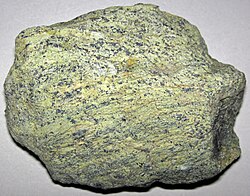


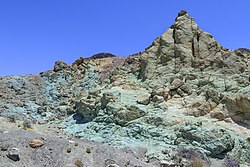

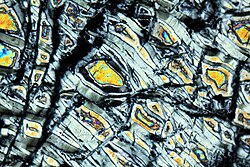

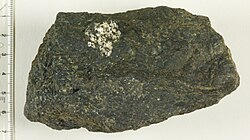

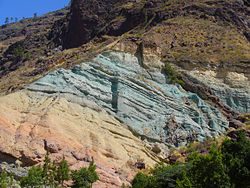

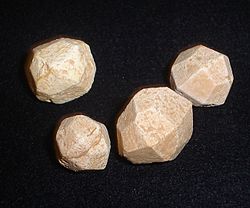




Relevante Artikel
Alteration (Geologie)Als Alteration bezeichnet man in der Geologie, Lagerstättenkunde und Mineralogie die mineralogischen und chemischen Veränderungen eines Erzkörpers und/oder seines Nebengesteins, wobei die Minerale in einem Gestein in Sekundärminerale umgewandelt werden. Die entstehenden Umwandlungsprodukte können auf verschiedene Arten gebildet werden, etwa dadurch, dass sich bei gleichbleibender chemischer Zusammensetzung die Kristallstruktur der Minerale verändert. Alteration kann auch durch Änderung der chemischen Zusammensetzung geschehen, wenn etwa hydrothermale Lösungen oder vulkanische Gase mit Gesteinen reagieren und zu den dort enthaltenen Mineralen neue Stoffe hinzukommen oder entfernt werden. Die Umwandlungen können syngenetisch oder epigenetisch, aszendent oder deszendent sein. Das zugrundeliegende Prinzip ist die Anpassung des Minerals an veränderte chemische Umgebungsbedingungen zu einem stabilen Zustand. Häufig bilden die Umwandlungsprodukte dabei Pseudomorphosen nach den Ausgangsmineralen. Dagegen werden Umwandlungen durch meteorische Wässer im deutschen Sprachgebrauch in der Regel als Verwitterung bezeichnet. .. weiterlesen
